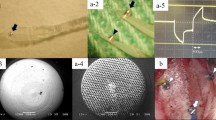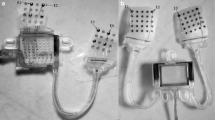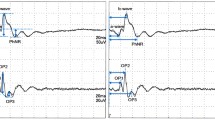Abstract
In this study, we aimed to determine the electrophysiological efficacy, safety, and electrical stability of a chronically implanted electrode for suprachoroidal transretinal stimulation (STS) in rabbit eyes. A platinum microelectrode was implanted into the scleral pocket of rabbit eyes (n = 5) and followed-up for 6 months. To evaluate the electrophysiological efficacy, electrically evoked potentials (EEPs) were measured every month after implantation. To evaluate safety, fundus examinations, fluorescein angiograms, electroretinograms (ERGs), and visually evoked potentials (VEPs) were measured before and every month after the implantation. At the end of the experiment, histological examination of retinal tissue beneath the site of the electrode was performed. To evaluate electrical stability, the resistance of the circuit was measured every month after implantation. EEPs could be elicited from the STS electrodes at all testing times. The mean threshold current to evoke EEPs was 186.4 ± 47.0 µA at 6 months after implantation. There was no significant change in the threshold over the follow-up period. The resistance of the circuit was significantly increased at 1 months after implantation, with no further increase at 6 months. There was no statistically significant change in the relative amplitudes and implicit times of a- and b-waves of ERGs and VEPs. No intraocular infection, inflammation, or vitreoretinal proliferation was observed in any eye. Histological examination revealed no retinal damage beneath the electrode. We conclude that chronically implanted electrodes for STS appear to be effective, safe, and electrically stable.





Similar content being viewed by others
References
Dobelle WH. Artificial vision for the blind by connecting a television camera to the visual cortex. ASAIO J. 2000;46:3–9.
Pezaris JS, Reid RC. Demonstration of artificial visual percepts generated through thalamic microstimulation. Proc Natl Acad Sci USA. 2007;104:7670–5.
Da Cruz L, Dorn JD, Humayun MS, et al. Five-year safety and performance results from the argus II retinal prosthesis system clinical trial. Ophthalmology. 2016;123:2248–54.
Chow AY, Chow VY, Packo KH, et al. The artificial silicon retina microchip for the treatment of vision loss from retinitis pigmentosa. Arch Ophthalmol. 2004;122:460–9.
Stingl K, Bartz-Schmidt KU, Besch D, et al. Subretinal visual implant alpha IMS–clinical trial interim report. Vision Res. 2015;111:149–60.
Rizzo JF 3rd, Wyatt J, Loewenstein J, et al. Methods and perceptual thresholds for short-term electrical stimulation of human retina with microelectrode arrays. Invest Ophthalmol Vis Sci. 2003;44:5355–61.
Brelen ME, Vince V, Gerard B, et al. Measurement of evoked potentials after electrical stimulation of the human optic nerve. Invest Ophthalmol Vis Sci. 2015;51:5351–5.
Nishida K, Kamei M, Kondo M, et al. Efficacy of suprachoroidal-transretinal stimulation in a rabbit model of retinal degeneration. Invest Ophthalmol Vis Sci. 2010;51:2263–8,2.
Fujikado T, Kamei M, Sakaguchi H, et al. One-year outcome of 49-channel suprachoroidal-transretinal stimulation prosthesis in patients with advanced retinitis pigmentosa. Invest Ophthalmol Vis Sci. 2016;57:6147–57.
Sakaguchi H, Kamei M, Fujikado T, et al. Artificial vision by direct optic nerve electrode (AV-DONE) implantation in a blind patient with retinitis pigmentosa. J Artif Organs. 2009;12:206–9.
Nishida K, Sakaguchi H, Kamei M, et al. Visual sensation by electrical stimulation using a new direct optic nerve electrode device. Brain Stimul. 2015;8:678–81,2015.
Stronks HC, Barry MP, Dagnelie G. Electrically elicited visual evoked potentials in Argus II retinal implant wearers. Invest Ophthalmol Vis Sci. 2013;54:3891–901.
Ward MP, Rajdev P, Ellison C, et al. Toward a comparison of microelectrodes for acute and chronic recordings. Brain Res;. 2009;1282:183–200.
Roitbak T, Sykova E. Diffusion barriers evoked in the rat cortex by reactive astrogliosis. Glia. 1999;28:40–8.
Turner JN, Shain W, Szarowski DH, et al. Cerebral astrocyte response to micromachined silicon implants. Exp Neurol;. 1999;156:33–49.
Rennaker RL, Street S, Ruyle AM, et al. A comparison of chronic multi-channel cortical implantation techniques: manual versus mechanical insertion. J Neurosci Methods. 2005;142:169–76.
Holecko MM II, Williams JC, Massia SP. Visualization of the intact interface between neural tissue and implanted microelectrode arrays. J Neural Eng. 2005;2:97–10235.
Nayagam DA, Williams RA, Allen PJ, et al. Chronic electrical stimulation with a suprachoroidal retinal prosthesis: a preclinical safety and efficacy study. PLoS One;. 2014;9:e97182.
Prince JH, Diesem DC, Eglitis I, et al. The rabbit. In: Anatomy and Histology of the Eye and Orbit in Domestic Animals. Springfield: Charles C Thomas; 1960. pp. 260–93.
Olsen TW, Aaberg SY, Geroski DH, et al. Human sclera: thickness and surface area. Am J Ophthalmol. 1998;125:237–41.
Tsui I. Scleral buckle removal: indications and outcomes. Surv Ophthalmol. 2012;57:253–63.
Zhou JA, Woo SJ, Park SI, et al. A suprachoroidal electrical retinal stimulator design for long-term animal experiments and in vivo assessment of its feasibility and biocompatibility in rabbits. J Biomed Biotechnol. 2008. https://doi.org/10.1155/2008/547428
Author information
Authors and Affiliations
Corresponding author
Ethics declarations
Conflict of interest
Ke. Nishida, None; H. Sakaguchi, None; M. Kamei, None; T. Saito, NIDEK Co., Ltd, Employment; T. Fujikado, None、Ko. Nishida, None.
Additional information
Publisher’s Note
Springer Nature remains neutral with regard to jurisdictional claims in published maps and institutional affiliations.
Rights and permissions
About this article
Cite this article
Nishida, K., Sakaguchi, H., Kamei, M. et al. Electrophysiological evaluation of a chronically implanted electrode for suprachoroidal transretinal stimulation in rabbit eyes. J Artif Organs 22, 237–245 (2019). https://doi.org/10.1007/s10047-019-01095-6
Received:
Accepted:
Published:
Issue Date:
DOI: https://doi.org/10.1007/s10047-019-01095-6




